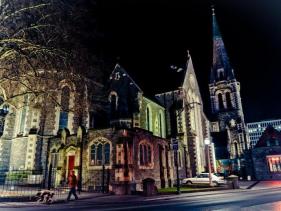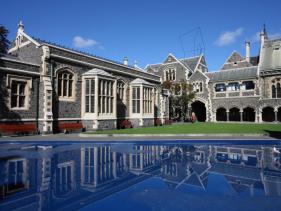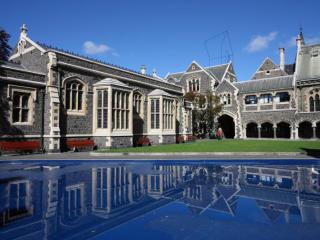For information on local attractions click here
To view images of Christchurch visit our Photo Gallery



Last Tram Out Of New Brighton
First Inhabitants
The first people to live in the place now known as Christchurch were moa hunters, who probably arrived there as early as AD 1000. The hunters cleared large areas of mataī and tōtara forest by fire and by about 1450 all the moa had been killed off.
North Island Māori (Ngati Māmoe and later Ngāi Tahu) arrived in Canterbury between 1500 and 1700. The remaining moa hunters were killed or taken into the tribes.
Hāwea, Rapuwai and Waitaha
According to Māori oral traditions the earliest peoples to inhabit Te Waipounamu were tribal groups known as Hāwea, Rapuwai and Waitaha who inhabited the island for centuries before the arrival of more recent tribal migrations of Ngāti Māmoe, Ngāti Wairaki and Ngāi Tahu. The early moa hunting tribes are believed to have been established in Canterbury about one thousand years ago.
Today, little is known of the traditions of Hāwea and where they originated from.
By 1800 the Ngāi Tūāhuriri sub-tribe of Ngāi Tahu were in control of the coast from the Hurunui River in the north to Lake Ellesmere in the south. Their largest settlement was a fortified pā at Kaiapoi. This was also a major trading centre for pounamu or greenstone.
With thanks to Christchurch City Libraries Read more ….
Early European Contact
1770 on 16th February Captain James Cook in his ship the Endeavour first sighted the Canterbury peninsula. He thought it was an island, and named it Banks Island after the ship’s botanist, Joseph Banks.
1840 in August Captain Owen Stanley of the Britomart raised the British flag at Akaroa, just before the arrival of sixty-three French colonists on the Comte de Paris.
1843 William and John Deans arrived and established a farm at Pūtaringamotu (Riccarton). With the Manson and Gebbie families they built the first European house on the Canterbury Plains. They named the area Riccarton after the parish they came from in Scotland, and the nearby river the Avon, after a stream on their grandfather’s farm.
The Canterbury Settlement
1847 John Robert Godley and Edward Gibbon Wakefield met to plan the Canterbury settlement.
Wakefield believed that colonisation of countries like New Zealand could be organised in such a way that towns could be planned before settlers arrived. These towns would be like a community back in England, with landowners, small farmers and workers, and with churches, shops and schools.
Part of the plan included the opportunity for the new settlers to buy land. This would supply the money needed for public works such as roads and schools. But first the land had to be bought from the Māori owners.
Three towns were planned Christchurch, Sumner and Lyttelton (named after Lord Lyttelton, chairman of the Canterbury Association)
1848 the Canterbury Association was formed, and it was decided to name the capital city Christchurch after the college John Godley had gone to at Oxford University.
1850 four ships the Randolph, the Cressy, the Sir George Seymour and the Charlotte Jane brought the first organised group of settlers to the Canterbury Association’s new settlement. First of the ships bringing settlers to Christchurch was the Charlotte Jane which arrived in Lyttelton on the morning of December 16.
1856 Christchurch became a City by Royal Charter on the 31st July this was because it was the ‘seat’, or base, for a bishop.
In 1859, Yorkshireman Enoch Barker came to Christchurch as government gardener. He established a nursery and planted avenues of trees around Hagley Park. It was he who planted the first official tree establishing the Botanic Gardens.
1862 Christchurch was made a municipal district, and John Hall elected the first chairman of the Municipal Council.
1862 Street lighting introduced.
1870 Canterbury Museum, designed by Benjamin Mountfort and was built.
1904 Christchurch cathedral was completed with the foundation stone being laid in 1864, from the 1880s Christchurch was known as the Cathedral City’.
1883 The Canterbury Frozen Meat company started frozen meat around the world.
1891 Ballantynes became the first store in Christchurch to be lit by electricity.
1861 Christchurch Press goes to press.
1867 Railway tunnel completed from Christchurch to Lyttelton was completed.
1876 Timeball Station in Lyttelton constructed to signal ships in harbour
1868 Christchurch saw its first paid fire fighters.
1881 First woman Master of Arts in British Empire graduates in Christchurch.
1882 Saw steam and horse trams running.
1883 Antigua Boat Sheds where built by two Lyttelton boat builders Albert Shaw and J.T. Tidd a Christchurch icon.
1885 at a public meeting in St Mary's Church, Christchurch, Reverend Thomas Flavell and Dr Walter Hacon proposed that the St John Ambulance Association be introduced to the colony. Their initiative led to the rapid establishment of St John throughout New Zealand.
1892 First women's Christchurch cycling club in Australasia formed.
1892 The Canterbury Women's Institute was formed with Kate Sheppard playing a leading role.
1893 19th September first women in the world to be given the right to vote bought about by the efforts of Kate Sheppard “of Christchurch” and her fellow WCTU members
1894 New Zealand Cricket Council formed in Christchurch.
1894 The first New Brighton pier of wooden construction opened on 18th January and was demolished on 12 October 1965.
1896 The District Nursing Association formed by Nurse Maude and continues to care for the people of Canterbury.
1905 Electric trams establish they ran until 1954.
1924 11 November Armistice Day Bridge of Remembrance memorial was unveiled for recognition to those that lost their lives in World War1. Now serves as a memorial for those who participated in two World Wars as well as subsequent conflicts in Borneo, Korea, Malaya, and Vietnam.
1944 The original paddling pool was constructed in the Botanic Children’s Playground.
1947 18 November Ballantynes the prestigious Christchurch department store was destroyed by one of the worst fires in New Zealand’s history killing 41 people.
1964 27 June The Beatles arrive in Christchurch for concert.
1964 Lyttelton road tunnel opened 110 years after it was first mooted and was hailed by the community as the new gateway from the Port to the Plains. It was a significant development in the history of the region.
The tunnel cost 2.7 million pounds to build taking three years to build and it was said to be 'among the most modern in the world'. At 1944m long it became, and remained until 2017, New Zealand’s longest functioning road tunnel.
1968 10th April the Lyttelton to Wellington passenger ferry the Wahine sank in outside of Wellington with a loss of 51 souls on the day and was New Zealand’s worst modern maritime disaster.
1971 21st April Court Theatre stages first play The Prime of Miss Jean Brodie.
1971 New Brighton Whale Pool and play area opens which became an icon.
1972 30th September New Christchurch Town Hall opens it is renowned for its good acoustics rated by the Guardian as being in the top 10 world’s best concert halls due to its revolutionary design using wooden panels on the walls to ceiling “Designed by prominent Christchurch architects Warren and Mahoney.
1974 on the 25th January saw the first day of competition at Christchurch Commonwealth Games called the Friendly Games held at QE2 Stadium.
Canterbury runner Dick Tayler ensured the success of the Games with a surprise victory against English world record-holder David Bedford in the 10,000 m race.
His winning time of 27 minutes 46.4 seconds was then the sixth fastest 10,000 m ever run. No New Zealander ran faster until Zane Robertson recorded 27 minutes 33.67 seconds at the Rio Olympics in 2016.
1980 The introduction of nationwide Saturday trading came about then seven-day trading in 1990's
1995 Opened the first of the historic central city trams.
1997 The current concrete New Brighton pier was opened on the 1st November it is one of the icons of Christchurch.
2010 4th September 7.1 earthquake rocks Canterbury with considerable damage in central Canterbury, especially in Christchurch, but with no loss of life.
2011 At 12.51 p.m. on Tuesday 22 February a magnitude 6.3 earthquake caused severe damage in Christchurch and Lyttelton, killing 185 people and injuring several thousand.
2013 In November the tramway reopened on a limited route from New Regent Street to Worcester Boulevard.
2014 In November the full tram route reopened to the 25 minute loop, with10 location stops from Worcester Blvd, Rolleston Ave, Armagh and New Regent streets, before passing through Cathedral Junction back to Cathedral Square.
2017 On 13 February two bush fires started on the Port Hills of Christchurch. These became one over the next two days the very large wild fire extended down both sides of the Port Hill almost reaching Governors Bay, to Westmorland, Kennedys Bush, and Dyers Pass Road almost down to the Sign of the Takahe. Eleven houses were destroyed by fire, over one thousand residents were evacuated from their homes, and over 2,076 hectares of land has been burned along with many trees including those around the newly established mountain bike track. The track management were also blamed for spreading the fire by keeping their chair lift running.
Whilst helping to fight the fire helicopter pilot and war hero Steve Askin died in a crash.
Steve Askin was wounded during a long gun battel in 2011 after the Taliban stormed the InterContinental Hotel in Kabul.
2018 Timeball Station in Lyttelton restored after earthquake damage.
2018 New Brighton new Whale Pool opens.
2019 15 March two consecutive terrorist shooting attacks at mosques.
2019 Christchurch received prestigious international compassion award.
The city was also be made a compassionate city, joining more than 400 other cities around the world.





